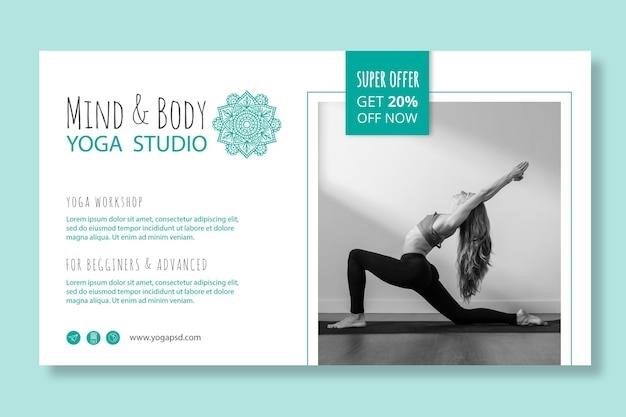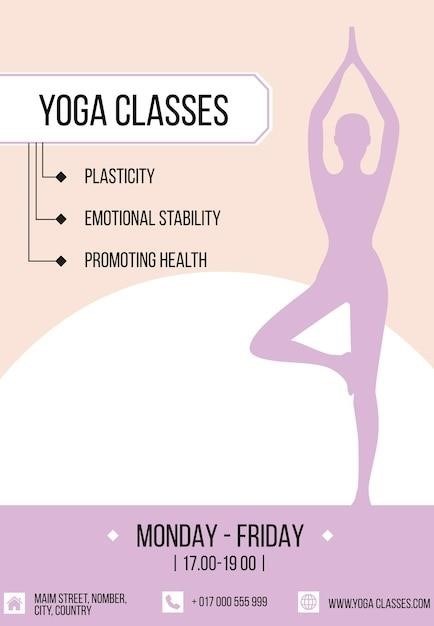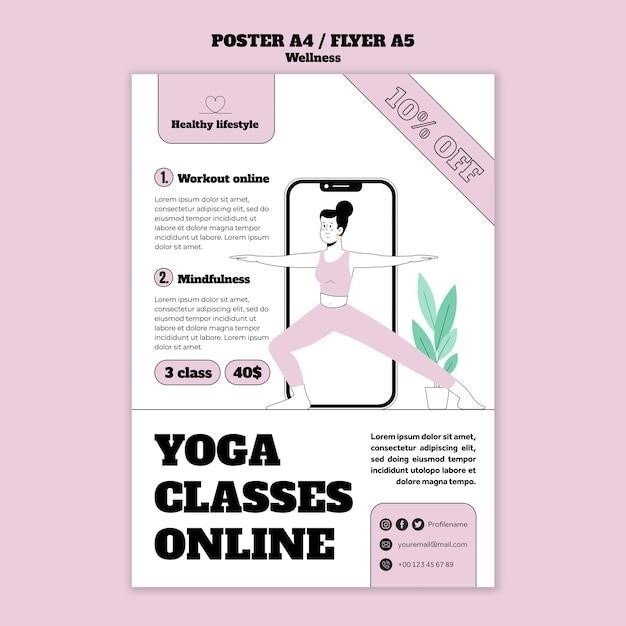Yoga for Beginners⁚ A Comprehensive Guide (PDF)
Download this comprehensive guide to begin your yoga journey․ Learn fundamental poses, breathing techniques, and how to build a sustainable home practice․ Perfect for absolute beginners!
Getting Started⁚ Your First Yoga Session
Embarking on your yoga journey begins with a comfortable and supportive environment․ Find a quiet space where you can relax and focus, free from distractions․ Wear comfortable clothing that allows for ease of movement․ A yoga mat is recommended for cushioning and grip, but a carpeted floor also works․ Begin with a few minutes of gentle stretches to warm up your muscles․
Focus on your breath․ Deep, controlled breathing is fundamental to yoga․ Inhale deeply through your nose, filling your lungs completely, and exhale slowly through your mouth․ Start with simple poses like child’s pose (Balasana) and cat-cow (Marjaryasana to Bitilasana) to gently ease into the practice․ Hold each pose for a few breaths, focusing on your body’s sensations․ Remember, consistency is key, even if you start with just 10-15 minutes of practice․ Listen to your body and don’t push yourself beyond your limits․
As you progress, gradually increase the duration of your practice and explore new poses․ The initial sessions are about developing body awareness and establishing a connection between your mind and body through movement and breath․ Enjoy the journey of self-discovery and the calming effects of yoga․ This initial experience lays the foundation for a lifelong practice․
Essential Yoga Poses for Beginners
Several foundational poses form the bedrock of a beginner’s yoga practice․ Mountain Pose (Tadasana) cultivates proper alignment and grounding․ Downward-Facing Dog (Adho Mukha Svanasana) lengthens the spine and strengthens the arms and legs․ Plank Pose engages the core and builds strength․ Child’s Pose (Balasana) offers a resting pose for relaxation and stress relief․ Warrior II (Virabhadrasana II) improves balance and builds strength in the legs․
Cobra Pose (Bhujangasana) gently stretches the chest and abdomen․ Triangle Pose (Trikonasana) lengthens the sides of the body and improves flexibility․ Tree Pose (Vrksasana) enhances balance and focus․ Seated Forward Bend (Paschimottanasana) stretches the hamstrings and spine․ Bridge Pose (Setu Bandha Sarvangasana) opens the chest and strengthens the back․ Mastering these poses provides a solid foundation for more advanced asanas․
Remember to maintain proper alignment and listen to your body throughout․ Focus on your breath and hold each pose for several breaths before transitioning to the next․ Regular practice will build strength, flexibility, and balance․ Always consult a qualified instructor for guidance and modifications if needed․
Breathing Techniques (Pranayama) for Relaxation
Pranayama, the practice of controlled breathing, is integral to yoga․ Deep, conscious breathing calms the nervous system and reduces stress․ Begin with Dirga Pranayama, or three-part breath․ Inhale deeply, filling the abdomen first, then the rib cage, and finally the upper chest․ Exhale completely, reversing the process․ Practice this for several minutes daily․
Nadi Shodhana, or alternate nostril breathing, balances the energy channels in the body․ Use your right thumb to close your right nostril, inhaling through the left․ Close the left nostril with your right ring finger, exhale through the right․ Inhale through the right, close the right, exhale through the left․ Continue this rhythmic pattern for several rounds․
Ujjayi breath, or “ocean breath,” involves a gentle constriction in the throat, creating a soft, whispering sound with each breath․ This technique helps to calm the mind and deepen the practice․ Experiment with these pranayama techniques, finding what resonates with you․ Consistent practice will enhance your relaxation and overall well-being, making it a valuable component of your yoga journey․

Understanding Yoga Asanas⁚ Key Principles
Yoga asanas, or postures, are more than just physical exercises; they are a holistic practice encompassing physical alignment, breathwork, and mental focus․ Understanding key principles enhances your practice and prevents injury․ Proper alignment is paramount․ Engage your core muscles to stabilize your spine and protect your back․ Avoid forcing yourself into poses; listen to your body’s limitations․ Modify as needed to maintain proper form․
Breath is the foundation of asanas․ Coordinate your movements with your breath, inhaling to lengthen and exhale to deepen․ This synchronicity promotes relaxation and enhances the benefits of each pose․ Focus on your breath, using it as an anchor to ground your attention․ Mindfulness is key․ Observe your body and mind without judgment․ Notice sensations without getting carried away by them․ This cultivates self-awareness and a deeper connection to your practice․
Consistency is crucial․ Regular practice, even if it’s just for a few minutes each day, yields significant benefits․ Start slowly and gradually increase the duration and intensity of your practice․ Remember, progress takes time and patience․ Enjoy the journey, and celebrate your achievements along the way․ Your body and mind will thank you for it․
Creating Your Home Yoga Practice
Establishing a consistent home yoga practice requires planning and dedication․ First, designate a dedicated space free from distractions․ Ensure adequate ventilation and comfortable temperature․ A yoga mat provides cushioning and grip, enhancing your comfort and stability during practice․ Gather any props you might need, such as blocks, straps, or blankets, to support your body and deepen your poses․ These aids are invaluable, especially when starting․
Next, curate a sequence of poses suitable for your skill level․ Begin with simpler asanas and gradually incorporate more challenging ones as you progress․ Numerous online resources and beginner-friendly yoga videos are readily available․ These provide guidance and visual demonstrations to help you learn proper form and alignment․ Remember, consistency is key․ Aim for a regular schedule, even if it’s only 15-20 minutes daily․ Consistency builds habit and allows your body to adapt and improve․ Treat your home practice as a cherished self-care ritual․
Finally, personalize your practice to fit your needs and preferences․ Experiment with different styles of yoga to discover what resonates with you․ Incorporate elements that enhance your well-being, such as meditation or mindful movement․ Your home practice should be a sanctuary for self-discovery, relaxation, and physical well-being; Listen to your body and adjust your routine as needed․ Enjoy the journey of self-improvement, both physically and mentally․

Building a Consistent Routine
Transform your yoga practice from sporadic to sustainable․ Consistency unlocks physical and mental benefits․ Discover strategies for integrating yoga into your daily life, creating a lasting habit․
Setting Realistic Goals and Expectations
Starting a new practice, especially one as multifaceted as yoga, requires careful consideration of your goals and a realistic understanding of your capabilities․ Avoid the trap of comparing yourself to others or aiming for overly ambitious targets in the beginning․ Beginners often fall into the trap of trying to do too much too soon, leading to frustration and potential injury․ Instead, focus on establishing a consistent routine, even if it’s just 10-15 minutes a day․ Consistency is key to seeing progress and developing a lasting relationship with your practice․
Set small, achievable goals․ Instead of aiming to master advanced poses immediately, focus on mastering the fundamentals․ This might involve perfecting your alignment in basic poses like Mountain Pose or Downward-Facing Dog, or simply becoming more comfortable and confident in your breathing techniques․ Celebrate small victories․ Acknowledge and appreciate your progress, no matter how incremental․ This positive reinforcement will keep you motivated and engaged in your practice․ Remember, yoga is a journey, not a race․ Enjoy the process of learning and growing, and be patient with yourself․
Adjust your expectations as you progress․ As you become more experienced and confident, you can gradually increase the duration and intensity of your practice․ This might involve incorporating more challenging poses or exploring different styles of yoga․ But remember to always prioritize safety and listen to your body․ Never push yourself beyond your limits, and always allow for rest and recovery․
Common Mistakes to Avoid
Many beginners unknowingly make common mistakes that can hinder their progress or even lead to injury․ One frequent error is neglecting proper warm-up․ Jumping straight into intense poses without preparing your muscles and joints can lead to strains and pulls․ Always begin with gentle movements and stretches to increase blood flow and prepare your body for the practice․ Another pitfall is ignoring proper alignment․ Incorrect alignment can reduce the effectiveness of poses and increase the risk of injury․ Focus on maintaining correct posture and alignment, even if it means modifying poses to accommodate your body’s limitations․ Seek guidance from experienced instructors or refer to reliable resources to ensure you understand proper form․
Holding your breath during poses is another common mistake․ Yoga emphasizes the importance of breathwork, and holding your breath can restrict oxygen flow and increase tension in your body․ Remember to breathe deeply and consistently throughout your practice, coordinating your breath with your movements․ Furthermore, comparing yourself to others is detrimental․ Everyone progresses at their own pace, and comparing yourself to more advanced practitioners can lead to discouragement and frustration․ Focus on your own journey and celebrate your individual progress․ Finally, neglecting rest and recovery is crucial․ Pushing yourself too hard without allowing your body adequate time to rest can result in burnout and injury․ Incorporate rest days into your routine and listen to your body’s signals․
Modifying Poses for Your Body
Yoga is adaptable to various body types and limitations․ Don’t feel pressured to achieve the “perfect” pose as depicted in images or videos․ Your body is unique, and modifications are essential for a safe and effective practice․ If a pose feels too challenging, start with simpler variations․ For example, instead of a full downward-facing dog, you might modify it by bending your knees slightly, which reduces stress on your hamstrings and lower back․ Similarly, in standing poses, you can widen your stance for better balance and stability․ Using props such as blocks, straps, or blankets can significantly aid in modifying poses․ Blocks provide support under your hands or feet, allowing you to maintain proper alignment without straining your muscles․ Straps can help lengthen your reach or provide support in poses where flexibility is limited․
Blankets offer cushioning and support, making poses more comfortable and accessible․ Don’t hesitate to use chairs or walls for support, especially in balancing poses․ Remember, the goal is to cultivate a practice that respects your body’s limitations and promotes comfort․ Modifying poses helps prevent injuries and ensures you derive the maximum benefits from your practice without pushing yourself beyond your capabilities․ As your flexibility and strength improve, you can gradually progress to the full expressions of the poses․ Always prioritize safety and listen to your body’s feedback throughout your practice․
Listening to Your Body⁚ Rest and Recovery
In the pursuit of flexibility and strength, it’s crucial to prioritize rest and recovery․ Ignoring your body’s signals can lead to injuries and burnout, hindering your progress․ Pay close attention to any pain or discomfort during your practice․ Sharp, shooting pains are a clear indication to stop and modify the pose or rest altogether․ A gentle ache is often acceptable, but pushing through intense pain is never advisable․ Your body needs time to repair and rebuild after each session․ Adequate sleep is essential; aim for 7-9 hours of quality rest each night․ Proper nutrition plays a vital role in supporting muscle recovery and overall well-being․ Hydration is equally important; drink plenty of water throughout the day, especially before, during, and after your practice․
Incorporate rest days into your weekly routine․ These days allow your muscles to recover and prevent overtraining․ Consider active recovery methods such as gentle walks or light stretching on rest days․ These can enhance flexibility and blood flow without stressing your muscles․ Listen to your body’s cues; if you feel fatigued or unwell, prioritize rest over pushing yourself to practice․ Regular rest is not a sign of weakness but a testament to your commitment to a sustainable and injury-free yoga journey․ Remember, consistent, mindful practice combined with adequate rest leads to the best results and a long-lasting, enjoyable yoga experience․
Finding Your Yoga Community (Optional)
While a home practice is perfectly viable, connecting with a yoga community can significantly enhance your journey․ The shared experience fosters motivation, accountability, and a sense of belonging․ Studio classes offer structured learning, expert guidance, and the opportunity to learn from experienced instructors․ The energy of a group class can be incredibly motivating, pushing you to challenge yourself in ways you might not on your own․ Furthermore, interacting with fellow practitioners creates a supportive environment, allowing you to share experiences, ask questions, and learn from others’ journeys․
Finding the right studio involves exploring different options․ Consider factors like class styles, instructor experience, studio atmosphere, and proximity to your home․ Attend a few introductory classes to assess whether the studio’s vibe aligns with your preferences․ Many studios offer introductory packages, allowing you to try different classes before committing to a longer-term membership․ Online communities also provide a sense of connection, offering forums, social media groups, and online classes․ These digital spaces allow you to connect with practitioners globally and participate in virtual classes, regardless of your location․ Whether in-person or online, a supportive community can greatly enrich your yoga practice․
